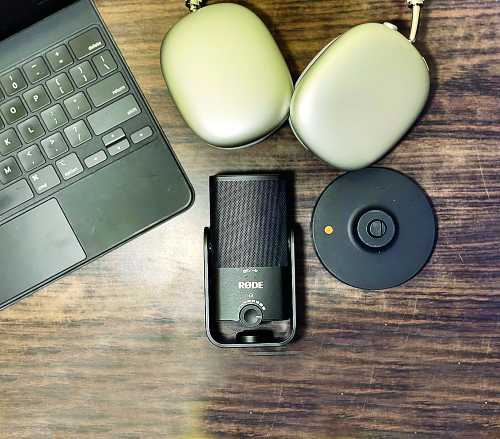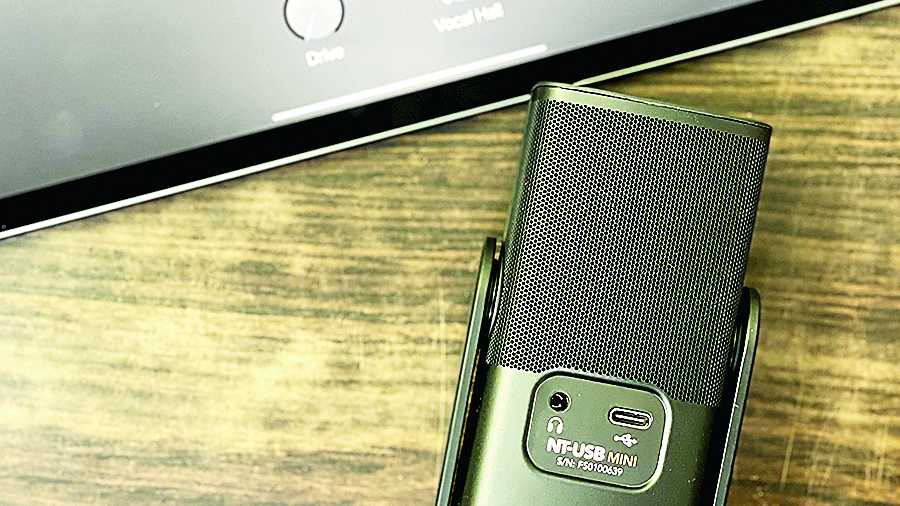Dr Frasier Crane’s sonorous voice told an upscale Seattle — episode after episode — how complex yet beautiful life is... with a lot of help from the iconic Electro-Voice RE20 microphone, which produces a mellow sound profile. It’s a professional dynamic cardioid microphone with studio condenser-like performance that doesn’t come cheap and may not be the best option for someone taking baby steps into podcasting. Instead, try the Rode NT-USB Mini, which is a plug-and-play option offering sonic bangs and booms.
On my desk for the past few days, the best deal with this microphone is that it connects to an iPad without hassle, which speaks volumes knowing how complex a relationship Apple shares with products from other companies. Though it can also connect to a Windows-driven computer using the USB-C to USB-A cable in the box, for the iPad you need to have a USBC-C to UBS-C cable, which is probably lying around the house.
Before going any further, allow me to clarify that using a USB microphone is not the best of options for someone looking at podcast in the long run, by which we mean professionally and for years. If you’re using a USB microphone, you won’t be able to use the audio interface at the same time. If you have and are using an interface, a mic that uses an XLR connector is recommended. That brings me to why I have chosen Rode NT-USB Mini: simply because podcasting for me is one more thing on the list, something to do once a week.
What surprises me the most about NT-USB Mini is its build — metal body with a solid grille and built-in pop filter, which is absolutely stunning to have for around 10K. Second, the stand or mounting system, which magnetically connects to the s-pop stand but if you want to mount this to a boom arm, you will need to take out the rubber bit and then use the 5/8 to 3/8-inch stand adapter that comes in the box.

Rode NT-USB Mini comes with a detachable magnetic stand that’s sturdy and looks great on any desk
The microphone can rotate 360 degrees while on the front of the device are two lights — the first being a zero-latency monitoring meter light, which can be on or off, and a USB connection light that lets you know that you have successfully connected to the computer. On the front is a volume dial which only controls the 3.5mm output on the rear of the microphone and it also doubles as a button to turn on or off zero-latency monitoring. Things can’t get any easier than this.
Most impressive is the output. This microphone has a cardioid polar pattern, a frequency response of 20Hz to 20kHz, max SPL of 121dB and sample rate of 48kHz. Having zero-latency monitoring makes me lean towards this option and Rode has focused on a single capsule and a single polar pattern instead of doing too many things; ensuring the sound is as good as it can get.
There are two excellent use cases for it. First, the spoken word or podcasting. The output has sonic gravitas, which most users demand. Though you don’t get the modern v-shaped sound with a lot of bass and treble while a somewhat recessed mid section, this is enough to get things moving for a podcast newbie. Second, it’s an excellent microphone for singing since there is a smooth mid section and a nice sheen to the treble. But I wouldn’t use this to record an electric guitar because the sound can be sharp at higher frequencies.
Let’s look at the noises that may get captured while podcasting. Usually one tends to keep such a small microphone on the table on which there is a keyboard. The microphone’s off-axis rejection capabilities are quite good but banging on the keyboard will certainly not be helpful to the recording process. I suggest you get an inexpensive boom arm. While recording, if you are on top of the device, you may sound like David Attenborough’s younger version but it’s best to stay a few inches away. A feet away… you will be heard but anything more than that is not suitable. Also, the stand being short, you may have to lean into the microphone to get that perfect sound… so a boom stand is welcome.
It all boils down to the question of how much one should spend on a microphone. There are some excellent and expensive options from Rode but do you need it? When a singer decides on a cappella, something will be amiss in the output but once instruments are added and you are performing something like a cover of Senorita, it will be difficult to fault this microphone. For amateur podcasters, this is it; look no further. Rode NT-USB Mini is a versatile microphone, capable of a mellow sound profile.
At a glance

On the back of the microphone are two ports — 3.5mm headphone jack input and USB-C
Device: Rode NT-USB Mini
Price: Rs 10,999
High notes
• Allows zero-latency monitoring
• Excellent for amateur podcasters and singers
• Connects easily to an iPad, PC or laptop
• Solid build
Muffled notes
• The stand is of excellent quality but short; get a boom arm
• The USB-C to USB-A cable in the box could have been longer










